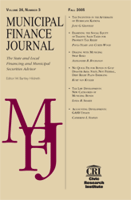The Effect of Tax Increment Finance on Local Government Financial Condition
Author: Kenneth A. Kriz.
Source: Volume 22, Number 01, Spring 2001 , pp.41-64(24)

< previous article |next article > |return to table of contents
Abstract:
Public perception of TIF has always been somewhat tenuous. There is widespread concern that TIF diverts resources that could be better used elsewhere. In addition, there have been concerns raised about whether developers are using TIF and other economic development incentives to “play off” cities against one another in order to make additional profits, demanding incentives even though they would have moved their operations to an area anyway. A final commonly asked question, both in practice and in academic literature is, What is the effect of TIF on local government finances? Many practitioners and academics have struggled with this question. The answer usually takes one of two forms. These have been termed the “pure capture” and “pure attribution” answers. The pure capture answer views TIF as simply a means to redirect public resources to subsidize development. Proponents of this view argue that all development would likely occur without the use of public subsidy. Therefore, any resources expended on TIF are a pure subsidy to developers. The pure attribution answer sees TIF as a necessary incentive to lure businesses to areas that would likely never be developed, at least for a period of several years. Any resources going to TIF are merely investments that pay off handsomely in the future. This article takes a different look at this topic. Using a probability-based analysis technique called Monte Carlo simulation, the probabilities of a positive financial outcome are analyzed. Through simulating the model developed here under various scenarios several important questions can be answered, notably: 1. What is the likely effect of TIF projects on local government financial condition? 2. Are TIF projects good investments for local governments, that is, are they likely to produce rates of return justifying their use? 3. Under what conditions are the best financial results obtained?Keywords:
Affiliations:
1: Hubert H. Humphrey Institute of Public Affairs, Universityof Minnesota.